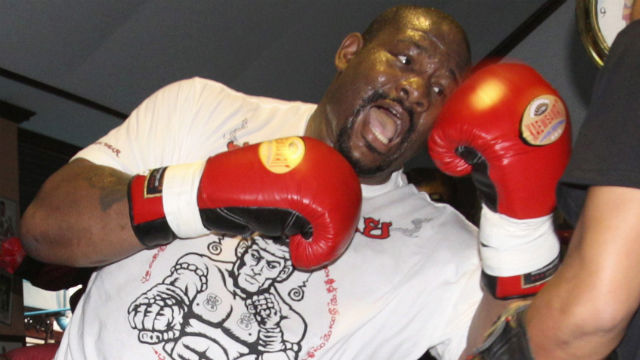CANASTOTA, N.Y. — When Ray Mancini got the call, he was caught off guard.
"It was pretty incredible. Who gets in the Hall of Fame?" the boxer known as "Boom Boom" marveled Thursday at his selection for the International Boxing Hall of Fame. "I don’t know exactly what it takes to get in there. It’s the culmination of a career. It’s terrific.
"I’m so honoured to be with my heroes, and there’s a couple of guys I beat pretty good," said Mancini, chuckling. "I never thought of myself as a Hall of Famer. It never even crossed my mind."
The rest of the class of 2015 announced Thursday includes heavyweight champion Riddick Bowe, featherweight champion "Prince" Naseem Hamed of England, light flyweight champion Yoko Gushiken of Japan, manager Rafael Mendoza of Mexico, referee Steve Smoger of Norfolk, Virginia, journalist Nigel Collins of England, and broadcaster Jim Lampley of Asheville, North Carolina.
Posthumous honorees include Japanese flyweight Masao Ohba, middleweight Ken Overlin of Decatur, Illinois, and publicist John F.X. Condon of New York.
Mancini, the pride of Youngstown, Ohio, followed his late father, Lenny, into boxing and turned pro in 1979. He captured the NABF lightweight title in 1981 from Jorge Morales and in 1982 scored a first-round knockout of Arturo Frias to win the WBA lightweight title.
That might have been his crowning moment. His dad was "Boom Boom" first, a promising fighter who never got that title fight he was oh-so-close to achieving when World War II intervened.
"My father was my inspiration. My mother was my motivation," Mancini said. "She always told me I could be anything I want in this world. I had a great balance. I wish they were here with me. They’d be floating. They’d be so proud, so happy."
Though his career was brief, Mancini was wildly popular and left an impact on the sport.
In November 1982, he defended his title against 23-year-old challenger Duk Koo Kim of South Korea at Caesars Palace in Las Vegas in an outdoor bout televised live by CBS. Mancini scored a knockout in the 14th round, but Kim suffered brain injuries that led to his death four days later.
The WBA immediately shortened its title fights to 12 rounds and by 1990 all sanctioning organizations had followed suit. But Kim’s death was a cruel reminder of the perils of the sport.
Mancini also made successful defences against Ernesto Espana, Orlando Romero, and Hall of Famer Bobby Chacon before losing the title to Livingstone Bramble in 1984 and in their rematch the next year. He officially retired in 1992 with a pro record of 29-5 (23 KOs).
"I want to be remembered as a guy who gave everything he had — left it all in the ring — a pretty good fighter," Mancini said.
Bowe compiled a 104-18 amateur record that included a super heavyweight silver medal at the 1988 Seoul Olympics, losing the gold-medal fight to Lennox Lewis. Bowe became the undisputed heavyweight champ when he scored a decision against Evander Holyfield in 1992 for the three major crowns.
One of 13 siblings who grew up in poverty in Brooklyn, Bowe had somehow made his way to the pinnacle of the sport.
A 6-foot-5, 235-pounder, Bowe won his first 31 fights to get a shot at the title, knocking out all but two of them. He fought only 10 times after taking the crown and won nine of them, but it was evident his career was declining when he had to get up off the canvas to stop Holyfield in their third and final meeting.
Bowe suffered two straight beatings from Andrew Golota in 1996, although he won both fights because Golota hit him with low blows. In interviews after the second fight, Bowe’s speech was badly slurred and former manager Rock Newman persuaded him to retire.
Bowe then joined the Marines before quitting after only a few days of basic training. Out of the ring, his marriage quickly unraveled and he kidnapped his ex-wife and kids at gunpoint for what he thought would be a reconciliation. He served time in federal prison and after his release returned to the ring in 2004 and won three more fights, the last in 2008 to improve his pro record to 43-1 (33 KOs).
"He was just a big, wonderful kid," Newman told the AP in a 2000 interview. "In the middle of all this, he survived without using drugs or alcohol or anything."
Hamed learned to box at age 7 and turned pro in 1992. In the ensuing decade, he captured bantamweight, super bantamweight and featherweight titles and had an impressive string of 15 successful title defences before retiring in 2002 with a pro record of 36-1 (31 KOs).
The Tokyo-born Ohba turned pro in 1966 and compiled a 25-2-1 record before winning the WBA flyweight championship in 1970. He successfully defended the title five times over the next three years and in his lone bout outside his native country stopped Rocky Garcia in the ninth round in the United States. His last fight was a successful title defence over Thailand’s Chartchai Chionoi in January 1973. Three weeks later, he died at 23 from injuries suffered in an automobile accident, finishing with a pro record of 35-2-1 (16 KOs).
Overlin learned to box in the Navy and turned pro in 1931. Perhaps his finest moment was a 10-round victory over future heavyweight king Ezzard Charles. He retired in 1944 with a record of 135-19-9-2NC (23 KOs) and died in 1969 in Reno, Nevada.
Inductees were selected by the Boxing Writers Association and a panel of international boxing historians. They will be enshrined in June at the Hall of Fame in upstate New York.


